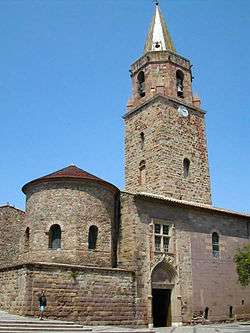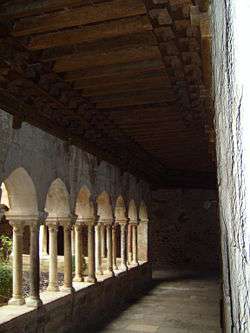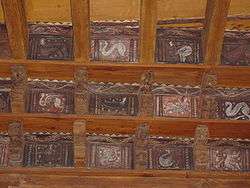Fréjus Cathedral



Fréjus Cathedral (French: Cathédrale Saint-Léonce de Fréjus) is a Roman Catholic co-cathedral, and a national monument of France, situated in the town of Fréjus in the Var department of Provence, in southeast France.
The cathedral, dedicated to Saint Leontius of Fréjus, has been the seat of the Bishop of Fréjus since the 5th century. The see was abolished in 1801 but restored under the Concordat of 1817. In 1957 the Diocese of Fréjus was united with that of Toulon to form the present Diocese of Fréjus-Toulon, with its seat at Toulon Cathedral.
The church is part of a complex of a larger fortified complex of medieval religious buildings dating from between the 5th and 13th centuries, when Fréjus was an important religious and commercial centre of Provence, comprising a parish church and a cathedral under one roof; a baptistery; the bishop's residence; a canonry, for the community of priests who served under the bishop; and a cloister.
The baptistery of the cathedral is a fine example of Merovingian architecture. It was built in the 5th century but hidden during later reconstruction, and was rediscovered in 1925 by French architect Jules Formigé. It is considered the oldest Christian structure in Provence, and one of the oldest in France.[1]
History
Fréjus, founded by Julius Caesar, had been an important Roman port and capital of Provence. The existence of a Christian community is documented as early as 374, but it is not known where they worshipped.[2] The foundation of the cathedral is traditionally attributed to Saint Leontius of Fréjus, bishop of Fréjus (ca. 419-ca. 488). During his time the first monastery in the region, Lérins Abbey, was also founded.
The cathedral is located close to what appears to have been the Roman forum of Fréjus; the ruins of monumental buildings have been found next to the cathedral under the garden of the former hospital, now the Palais de Justice. It was also near the cardo maximus, the principal north-south axis of Roman towns; its walls were aligned with the sites of earlier Roman villas; and elements of Roman buildings, such as columns and walls, were incorporated into its structure. Beginning in late Roman times, the town suffered a series of invasions and was pillaged by Goths, Burgundians, Franks, Lombards and Saracens. A plague carried away much of the population in the 6th century. In the 10th century Saracen pirates ravaged the coast.
The expulsion of the Saracens in 972 brought a period of relative peace. In the 12th century Fréjus was governed jointly by the Viscount of Fréjus, who had a castle near the port, and by the bishop, who lived beside the cathedral. The medieval town of Fréjus grew up around the cathedral. The town had shrunk considerably since Roman times: whereas the Roman walls had enclosed fifty hectares, the medieval walls of the 12th century enclosed only five hectares.[3]
At the end of the 12th century, the Count of Provence asserted his authority over both the church and state. He nominated the bishops of Fréjus, while the local nobles lost power. The old Roman road, the Via Aurelia, was abandoned; and the old Roman port gradually silted up and became an unhealthy swamp, carrying fever and disease to the town. Aside from a brief economic revival in the sixteenth century, which saw the building of a new city wall, Fréjus lost its economic importance, and the bishopric was moved in 1751 to Draguignan. By 1765 the population had declined to 2,000 people.[4]
Fréjus saw a new growth in population at the beginning of the 20th century, caused by a large immigration of Italians, and later growth caused by increasing tourism in the region. Today the population is about 47,000.
Baptistery
The baptistery is the oldest part of the cathedral, dating to the 5th century. It is similar in form to baptisteries in Northern Italy, at Albenga in Liguria, and to the Lateran Baptistery in Rome, from the same period. On the exterior, the lower part is a square, about eleven meters to a side. On top of that is a domed octagonal structure. In the interior, the lower level is divided into eight deep arched niches, alternating between semicircular niches and those with flat walls, with the arches resting on columns. The columns support the upper level, which has sixteen small arched niches with windows, which in turn support the dome. Many of the granite columns predate the church, and were probably taken from Roman temples; other columns were made at the same time as the baptistery.
In the centre of the floor is the octagonal baptismal basin, large enough for a person to be entirely immersed, surrounded by a stone ledge. A smaller basin is located in the floor nearby, either for the baptism of infants or for washing the feet of the priest.
In the 13th century the baptistery was surrounded by a new wall, and the baptismal basin was covered over. It was rediscovered in the 1920s by Jules Formigé, the Inspector of French Historical Monuments, and the interior was restored during the 1930s to what he believed to be its original appearance.
The Cathedral


The cathedral contains two naves, one of which belonged to the bishop, and the other to the local parish, side by side under the same roof, separated by arches. This arrangement was not unique in Provence; it is also found in Aix Cathedral and Apt Cathedral.
An earlier church, from the same period as the baptistery, stood on the same site, some vestiges of which, including a mosaic floor, have been found under the old bell tower and nave of the present church.
It appears that the two naves of the present church were probably built at different times. The church of St. Étienne (Saint Stephen) was probably begun in the 11th century, and enlarged in the 12th century, and became the parish church of the city. It consisted of a long nave under a barrel vault ceiling, divided on the north side into four parts by lateral arcades resting on massive rectangular pillars. The south wall, which connected the church to the cathedral of Notre Dame, was reconstructed in the 12th century to add greater strength and support for the new arcades that were constructed. The marks of the stonemasons can still be seen on the vault of the third traverse. Many of the stones appear to have been taken from earlier buildings, either Roman or later.
The nave and choir of the cathedral of Notre Dame were built next, in the 13th century, against the south wall of the church of St. Étienne. The first part constructed was the porch and bell tower, at the western end of the nave, between the baptistery and the nave. This part of the church, like the residence of the bishop at the other end, had a strongly military appearance, as if to stress the power of the bishop in temporal as well as spiritual affairs.[5]
The nave featured an apse and a new kind of vaulted roof, more modern than that of St. Stephen's church. This was a series of vaults supported by crossed ogives, in a style called Lombard. It used different kinds of arches: some perfectly rounded (en plein cintre), some more arched than a semicircle (outrepassé) and some less arched (segmentaire), allowing greater height and space. Once the cathedral's new nave had been built, larger arcades were built to open the wall between the two churches.
Cloister
The cloister, which served as a place of meditation for the bishop and the dozen canons who served him, was built in the 13th century on the north side of the cathedral. It consists of pointed arches resting on double Corinthian columns. The decoration of the capitals of the columns features the key, the symbol of the bishops of Fréjus, and the fleur-de-lis, the symbol of Charles I of Anjou, the brother of Louis IX of France, (Saint Louis), who had become the Count of Provence in 1246.
Painted Ceiling
An upper level was added to the cloister between 1350 and 1360, reached by a monumental stairway. The builders added a wooden ceiling to the lower level and decorated the brightly painted panels with biblical scenes, fantastic animals, and scenes of daily life. Only half of the paintings remain today, and the bright colours have been faded by oxidation, but they provide a remarkable look at medieval life and the medieval imagination.
The panels include paintings of the Virgin Mary and the Infant Christ; Saint Peter; several canons (recognizable by their fur hats); several priests praying or preaching; a demon with the tail of a serpent; angels playing instruments; a fallen angel with the wings of a bat; a centaur; a mermaid; a dragon; an elephant; a tiger; an ostrich; domestic animals, such as horses, dogs and pigs; and common wild animals, such as wolves and deer. People from ordinary medieval life are also portrayed; a butcher, a knight, a juggler, a young woman performing her toilet, and both a man and woman answering the call of nature. All together the panels portray the history of the world and ordinary life as known and imagined in the Middle Ages.
Bishop's Palace
A residence for the bishop apparently existed in the 5th century, just south of the cathedral. A more imposing palace for the bishop was built in the 11th and 12th centuries, which housed the bishop, the dozen canons and a dozen beneficiers. In the 13th century a separate building was built for the canons. The palace of the bishop was relatively small: 6.5 metres by 5 metres, and three storeys high, with a vaulted hall on the second floor and a terrace on the roof with a crenellated wall for defence. The building served as both a palace and a fortification, and was probably part of the massive wall of the city, three metres thick at its base.
For many centuries the bishops were from local aristocratic families, but in the 13th century they were appointees sent from the Papal Court at Avignon. The first of these bishops, Jacques Dueze, later became Pope John XXII, from 1316 to 1344. These new incumbents, with more income and more cosmopolitan tastes, transformed the residence from a fortress to a palace, greatly enlarging the space, building large halls and chapels. These works continued from the 15th to the 17th century, largely destroying the medieval residence, and replacing it with a palace in Renaissance style .
In the 18th century, as the city went into economic decline, the bishops of Fréjus began to neglect their residence, spending more and more time in Draguignan, the new seat of the bishopric. After the French Revolution the palace was abandoned for twenty years. In 1823 the new bishop decided to replace the structure completely. Most of the palace was demolished, and part of what remained became the present Hôtel de Ville in 1912.
Notes
Sources
| Wikimedia Commons has media related to Fréjus Cathedral. |
- Bastié, Aldo (2000). Les chemins de la Provence romane (in French). Rennes: Ouest-France. ISBN 2-7373-1430-5.
- Denizeau, Gérard (2003). Histoire Visuelle des Monuments de France (in French). Paris: Larousse. ISBN 2035052017.
- Fixot, Michel; Sauze, Elisabeth (2004). Fréjus : la cathédrale Saint-Léonce et le groupe épiscopal (in French). Paris: Monum, Éditions du Patrimoine. ISBN 2858227241.
- France Mediéval. Monum, Éditions du patrimoine/Guides Gallimard, 2004.
External links
- Diocese of Fréjus-Toulon (2013). "Cathédrale Saint-Léonce à Fréjus". Official website (in French). Retrieved 24 August 2013.
- Paroisse de la Cathédrale de Fréjus (2012). "Histoire de la Cathédrale". cathedrale-frejus.fr (in French). Retrieved 24 August 2013.
Coordinates: 43°25′59″N 6°44′13″E / 43.43306°N 6.73694°E